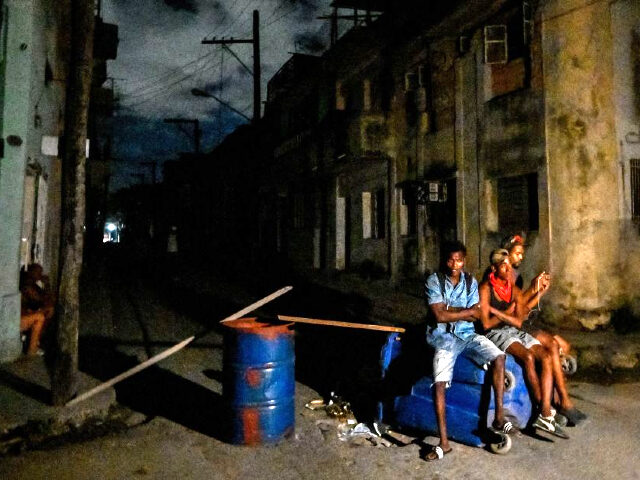The Communist Party of Cuba blamed burning sugar cane for a power outage that plunged half the island into darkness for hours on Monday, the latest in a series of electric failures that have fueled nearly incessant protests against the Castro regime.
Cuba has been experiencing routine electricity failures for much of the past year, a result of decades of socialist mismanagement of the power grid and neglect. The Castro regime has, for the majority of its 64 years in power, funneled most of its billions in profits into the lavish lifestyles of Castro family members and a small group of trusted sycophants. To the extent that it has invested in Cuba, it has dedicated funding to the tourism industry, reserved for wealthy foreign elites and illegal for Cubans to access for much of the Communist Party’s existence on the island.
While the Castro regime regularly complains that the island remains impoverished as a result of the American alleged “embargo” on the country – designed with so many loopholes that American politicians regularly visit Cuba – in reality, the Castro regime makes billions on tourism and human trafficking, particularly the sale of slave doctors and other health workers to allied regimes.
The blackouts led to dramatic protests during much of last summer and peaked in September after the devastating passage of Hurricane Ian, which left the entire island without power.
The latest blackout, according to Cuba’s Electric Union, began due to a “network failure … between Nuevitas and Sancti Spíritus” at around 2 p.m. local time on Monday. Sancti Spíritus is located nearly exactly in the center of Cuba, while Nuevitas is in northern Camagüey province, east-central Cuba.
The blackout reportedly cut the electrical service from central Cuba all the way down to southeast Guantánamo. The official newspaper of the Communist Party, Granma, claimed that the blackout took four hours and 49 minutes to solve, but Electric Union officials warned citizens that power service would be restored “gradually” in the following days to its full capacity, meaning many towns and cities would remain in the dark while service returned to others.
According to a post by the Electric Union, “the cause of the disconnect in service was the burning of sugar cane in the zone.”
“When sugar cane burns, the air ionizes and this can provoke failures in the phases between these lines of transmission,” a government explanation posted to social media claimed, confirming blackouts down into eastern Cuba, from Santiago de Cuba to Guantánamo.
Actualización de la nota informativa sobre la desconexión del servicio eléctrico en la zona Centro–Oriental. A las dos…
Posted by Unión Eléctrica UNE on Monday, February 13, 2023
In an attempt to preemptively quell any civil unrest, the Electric Union posted a photo it claimed showed its workers repairing the damage to Facebook. The low-resolution photo appeared to show two people wearing helmets atop an electrical pole and the attached message used the communist hashtags #BetterisPossible and #UniteandOvercome. The post elicited a string of laugh reaction emojis from Facebook users.
Brigada de Mantua trabajando en el proyecto de Acueducto de la localidad de Lázaro para dar servicio a ese pinareño territorio. #MejorEsPosible #JuntarYVencer
Posted by Unión Eléctrica UNE on Monday, February 13, 2023
On Tuesday, Energy and Mines Minister Vicente de la O Levy reported some modest improvements and confirmed that a burning sugar cane field was responsible for the damage. The government provided no details on what caused the offending fire, if officials had extinguished it, or what, if any, measures would be taken to prevent a repeat incident.
De la O has been in office for less than six months, taking over the ministry in October following the total blackout a month prior. The Castro regime also replaced the government-appointed administrator of the power grid; neither move appears to have improved the situation on the island.
Even prior to Hurricane Ian’s destruction, Cubans were experiencing daily, extended power outages nationwide, though far more frequently in poorer regions or areas less commonly frequented by foreign tourists. The protests prompted particularly vociferous protests in Nuevitas, Camagüey, where the police responded by beating residents with sticks. In one notable episode, in August, state security agents beat and arrested three girls between 11 and 12 years of age as the girls tried to defend their protesting parents from the blows. The girls told their story in a mobile phone video that traveled the world through the internet, resulting in the arrests of their mothers.
“I was holding on to my dad, and she was holding on to my dad, and then, to arrest my dad, the police had to hit us,” one of the girls narrated. “I also hit them because they hit me.”
Following the Hurrican Ian blackouts in September, the Castro regime shut off interest access to silence online dissent, which failed to contain public outrage. State media attempted to normalize the blackouts by November, airing news segments training citizens on how to survive on just three hours of electricity a day.
The Cuban Observatory of Conflict, an organization that tracks civil unrest on the island, documented nearly 4,000 protests throughout Cuba in 2022. The group cited lack of access to electricity as a major driver of the protests, though general discontent with the Castro regime and opposition to communism were the most pervasive themes.

COMMENTS
Please let us know if you're having issues with commenting.